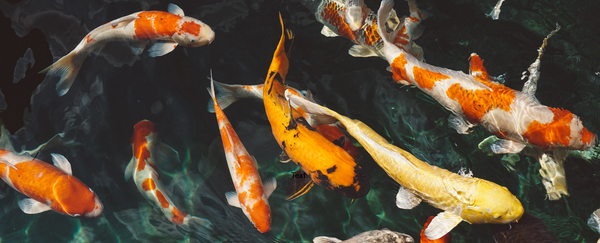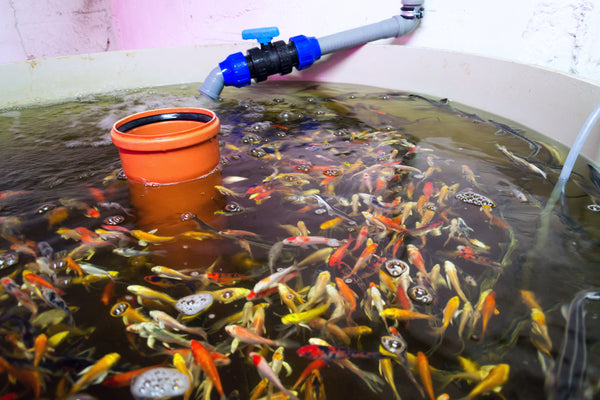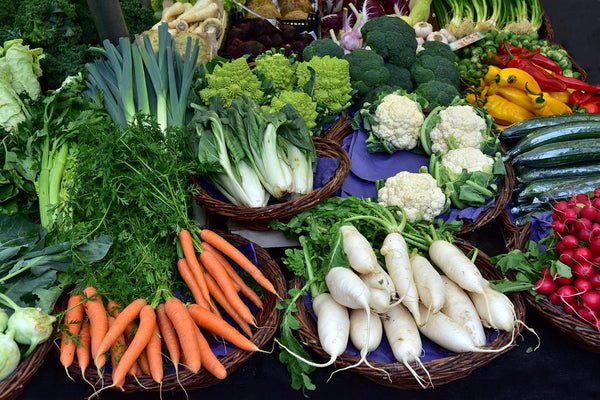Fish and plants, along with the bacteria, are the main components of an aquaponics system. The waste produced by fish is used as the source of nutrients for the plants to thrive. This article will discuss what fish and plants need to thrive in an aquaponics system for a successful and higher yield.
What do Fish Need in Aquaponics Systems?
One of the most important decisions you will have to make if you want to start your aquaponics system is which fish species to use. In an aquaponics system, fish plays a critical role as it produces the natural fertilizers needed by the plants to thrive.
Aquaponics allows you to raise a wide variety of fish species, and there are many options to suit your needs. However, to be successful, you need to carefully choose the best fish species to survive and thrive in your system.

Things to Consider in Choosing Fish for Aquaponics
To build a successful aquaponics system, you'll need to carefully select the fish that will thrive in your climate, location, and availability. It is also necessary to know and plan out the purpose of the fish in your system. Here are some key things to consider in selecting the best fish for your aquaponics system.
- Edible vs. ornamental
- Temperature
- Fish type and maintenance
- Size and space requirements
- Filtration capacity
- Breeding habits
The Most Common Fish Grown in Aquaponics Systems
Tilapia
Ideal pH Range: 6.5 - 9.Ideal Temperature Range: 82 - 86 °F
Ideal Fish Tank Size: A fully grown tilapia will weigh 1 pound, although they can grow larger. The rule of thumb is that one pound of tilapia will need 3 gallons of water. So this means that in every 3 to 5 gallons of water, only raise one tilapia.
Food Requirements: Tilapia are omnivore fish species that eat both plant and animal-based feed. In aquaponics, you can also feed with leftover vegetables and other alternative or homemade fish food.
If you’re looking to buy live tilapia fingerlings, click here.
Trout
Ideal pH Range: 6.5-8Ideal Temperature Range:14-16°C (57-60°F)
Growth Rate: 1000 grams in 14 to 16 months
Average Adult Size:12 kg (27 lbs)
Food Requirements: Trout requires a higher protein diet than Tilapia and carp.
Catfish
Ideal pH Range: 7 -8
Ideal Temperature Range: 65°F to 90°F
Ideal Fish Tank Size: large fish tank (at least 8 gallons of water per catfish)
Food Requirements: Catfish requires high-protein foods. They eat pellets, worms, or other homemade fish food.
Read our article, “How to Raise Catfish in Aquaponics Systems,” to learn more about raising catfish in aquaponics.
Largemouth Bass
Ideal pH Range: 6-8Ideal Temperature Range: 65°F - 80 °F
Ideal Fish Tank Size: A 100 to 150 gal (380 to 570 L) tank is a great size to start with. This would be enough to house eight fish, given they're no more than 10 inches in length.
Food Requirements: They are happy when fed with insects and worms but will also be satisfied with floating commercial pellets.
Salmon
Ideal pH Range: 7 - 8Ideal Temperature Range: 55°F - 65°F
Ideal Fish Tank Size: A 1000-L tank (264 G) is enough to house four fish for Atlantic salmon.
Food Requirements: Salmon can be fed with pellets that contain 70% vegetable ingredients and 30% marine ingredients like fish oil and fish meal.
Koi
Ideal pH Range: 6.5 - 8Ideal Temperature Range: 65°F - 78 °F
Ideal Fish Tank Size: A 1000-gallon tank will be enough to have 6-5 koi. They are also ideally grown on ponds.
Food Requirements: Koi are omnivores and are not difficult to feed as they will eat plant and animal matter. But for their optimum growth, giving high-quality feed is recommended.
Goldfish
Ideal pH Range: 6 - 8
Ideal Temperature Range: 78°F- 82 °F
Ideal Fish Tank Size: At least a 120-gallon tank for five single-tailed goldfish.
Food Requirements: Goldfish are omnivorous, meaning you can provide them with a broader range of diet options. However, it is recommended to stick to prepackaged fish feed, preferably high-protein pellets.

Fish Care
Fish highly depend on the water in which they live, so changes in the water will directly affect their health and well-being. Here are symptoms to look for when checking the health of the fish.
Symptoms of diseases to look out for:
- Cloudy or swollen eyes.
- Rapid movement of the gills.
- Distended or hollow stomach.
- Opaque, clamped, or frayed fins.
- Wounds, fungus growth, patches or spots of cloudy white/grey, or color changes in the skin.
- Unusual behavior. (unusual swimming patterns, darting around the tank in an alarmed fashion, hanging at the surface or hiding away and being unusually shy)
Causes of Fish Disease
Fish diseases can be introduced by new fish, plants, live food, invertebrates, or equipment used. There should be a delicate balance in the fish tank to ensure that the fish remain healthy. Fish carry bacteria, viruses, fungus, and parasites like all animals. Not all of these are harmful, but some of these microorganisms, called pathogens, can cause diseases.
Factors that can cause fish diseases:
- Your environment or low water quality.
- Not getting along with other fish in the fish tank.
- Poor or unbalanced diet.
- Fish stress.
How to Prevent Fish Diseases
- Purchase healthy fish seeds from a reputable and reliable hatchery.
- Never add unhealthy fish to the system. Examine and quarantine new fish in a separate fish tank for two weeks before introducing them into an established fish tank.
- Feed the fish with a good, varied, and well-balanced diet.
- Keep the water quality in your system clean, including cleaning the filter if you have one fitted to your system.
- Ensure the system is within the ideal range of pH, ammonia, nitrites, and nitrates for your particular fish.
- Add extra aeration. You can rarely have too much aeration.
- Reduce the frequency of opening and closing the lid on the tank and minimize scooping fish out to inspect them.
- Treat the disease as soon as it is identified.
What Do Plants Need in Aquaponics Systems?
With aquaponics, you can grow any plant you want. However, there are some things that you should consider before planting your first seeds. Some plants adapt better to a smaller system, while other nutrient-hungry plants require larger systems to thrive.
Things to Consider in Choosing The Best Plants for Your Aquaponics System
1. What Type of System You Are Going to Use?
This could be a media-based, NFT, or raft aquaponics system. These will determine the type of root structure that plants tend to have. Plants with small root structures will grow well in floating rafts, while root vegetables grow well in grow beds.
2. Plant Requirements
Choosing plants and fish with compatible pH range, water, and temperature requirements is essential. This will ensure that you can adjust your pH, water, and temperature to the ideal range accepted by the plants and fish.
3. Environment
The amount of sunlight, temperature, and rain is essential in growing a healthy plant. If you decide to grow outdoors, choose a variety of vegetables that will grow best in your climate.
4. Space Available
This refers to the amount of space available in your system.
5. The Number of Fish in the Fish Tank
It is essential to consider the fish to plant ratio in your system. If you plan on growing a lot of fish, you will need more plants to absorb all the nutrients from the fish waste.
6. What You Want to Grow
Thinking about what you want to achieve in your system will help you decide what plant to grow in your aquaponics system.

The Best Plants for Aquaponics Systems
Lettuce
Nutrient Requirement: LowpH Requirement: between 6.0 to 6.2
Temperature: between 60° to 70° F
Basil
Nutrient Requirement: LowpH Requirement: between 5.5 to 6.5
Temperature: between 65° to 85° F
Kale
Nutrient Requirement: LowpH Requirement: between 6 to 7.5
Temperature: between 55 ° to 70° F
Swiss Chard
Nutrient Requirement: LowpH Requirement: between 6.0 to 7.5
Temperature: between 60° to 75°F
Strawberry
Nutrient Requirement: Medium to High
pH Requirement: between 5.5 and 6.5
Temperature: between 60 to 80°F
Tomato
Nutrient Requirement: HighpH Requirement: between 5.5 to 6.5
Temperature: between 65°F to 85°F
Cucumber
Nutrient Requirement: High
pH Requirement: between 5.5 to 6.5
Temperature: 7.0

The Water Quality Parameters for Aquaponics
Dissolved Oxygen (DO)
The recommended DO level for aquaponics is 5 ppm or higher, depending on the fish species being raised. Warm-water fish like tilapia and catfish require that the DO not drop below 3ppm, and cold-water fish species like rainbow trout require that the DO not drop below 4 ppm to maintain good health and optimum growth. In aquaponics, especially in new systems, it is recommended to measure the DO levels frequently (daily) as low DO is a threat to the fish's health.
Factors that can affect DO levels.
- Cloudy and rainy days can cause DO to drop because there's less sunlight for the plants to photosynthesize and produce oxygen.
- Too many fish in the fish tank.
- Too much uneaten food left in the fish tank.
- Saline water.
pH
In aquaponics, it is essential to maintain a pH level that is acceptable to both fish and plants, which is 6.8 to 7.0. So, it is necessary to regularly test the pH levels of your aquaponics system to determine if normal aerobic conditions are present and avoid drastic changes in pH that can affect the plants, fish, and bacteria. There are ways to adjust the pH in aquaponics; these are:
- To raise pH
Use calcium carbonate and potassium carbonate and add equal amounts of each simultaneously.
- To Lower pH
You can use acids like nitric, muriatic, and phosphoric acids to lower the pH in your system. Rapid pH changes can be harmful to the fish. You can adjust the pH by adding acid to the system little by little and wait for it to distribute throughout the system before taking a retest. Repeat the process until your desired pH is achieved.
Water Temperature
The water temperature in the aquaponics systems will influence the type of fish raised, plant growth, and the biofilter's performance. Warm-water fish species such as goldfish, catfish, and tilapia prefer temperatures ranging from 65° to 85 °F, while cold-water fish species such as trout thrive at temperatures ranging from 55° to 65° F. Water temperature also affects the oxygen level in the water. So it is essential to measure the water temperature regularly.
Water Hardness
Water hardness can range from soft (0-75 ppm) to very hard (>300 ppm). In aquaponics, the water hardness should be maintained between 50 and 100 ppm.
Ammonia
It is essential to monitor the ammonia level regularly, as unionized ammonia concentrations can quickly reach the toxic levels in fish. To learn more about the role of ammonia in aquaponics systems, click here.






Sagau
August 26, 2021
After reading the articles provided by Go Green Aquaponics I began to understand how Aquaponics works. However, I have not read an article about the suitablity of fish tank made of cement. I will make a DIY Aquaponics garden. Thank you.